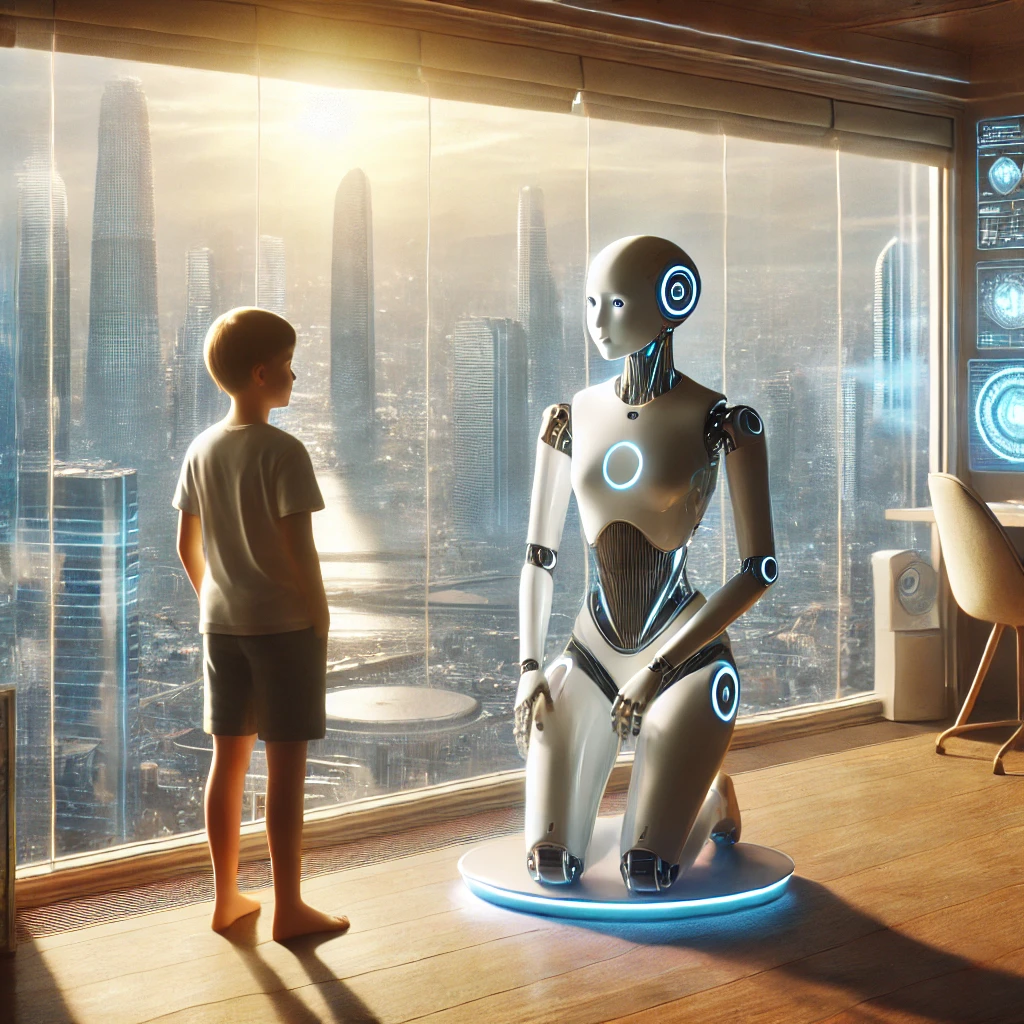Introduction to ‘Klara and the Sun’
‘Klara and the Sun’, a compelling novel by Kazuo Ishiguro, was published in March 2021, marking a significant entry into the science fiction genre. Ishiguro, an acclaimed author and Nobel Prize laureate, employs his signature style to explore profound themes encapsulating artificial intelligence and the essence of humanity. The novel unfolds through the perspective of Klara, anArtificial Friend (AF), designed to provide companionship and emotional support to children in a near-future world where technology pervades every facet of life.
Set against a backdrop of a society grappling with the implications of genetic manipulation and automation, Klara’s narrative invites readers to question the boundaries between human and machine. Ishiguro meticulously constructs a universe that reflects current anxieties surrounding technology, compelling readers to consider the ethical implications of creating sentient beings. Klara, with her observational prowess and emotional sensitivity, acts as a lens through which the intricacies of human emotions are examined, thus challenging the conventional notions of consciousness and empathy.
The premise of ‘Klara and the Sun’ revolves around Klara’s experiences in a world where artificial intelligence is not merely a tool but an integral part of human experience. Through her interactions with various characters, the novel delves into profound existential questions: What does it mean to be alive? Can artificial entities truly understand or replicate human emotions? As Klara navigates her reality, her journey raises important discussions about the potential of artificial intelligence and its role in shaping human relationships.
This introduction sets the stage for a rich exploration of human identity as juxtaposed with the capabilities of artificially created beings. Ishiguro’s work embodies a thought-provoking examination of our future, where the line between artificiality and authenticity becomes increasingly blurred.
Klara: The Protagonist and Artificial Friend
Klara, the titular character of Kazuo Ishiguro’s novel “Klara and the Sun,” stands as a compelling figure in the exploration of artificial intelligence and its relationship with humanity. Designed as an Artificial Friend for children, Klara embodies a unique perspective that offers insight into human emotions and interactions. Throughout the narrative, her observations and reflections reveal the intricacies of human behaviors, presenting a window into emotional complexity that readers can both relate to and ponder.
One of Klara’s defining traits is her keen ability to observe and analyze her surroundings. Positioned in the storefront of a store selling artificial friends, she spends her days watching human life unfold before her eyes, assimilating experiences through her selective attention. This observational capacity not only enhances her understanding of her human companions but also provides readers with a dual lens through which the intricacies of human relationships can be examined. As she interacts with Josie, her human companion, and encounters various adults in her environment, Klara’s responses often challenge traditional notions of empathy and emotional intelligence.
Moreover, Klara’s character invites discussion concerning the boundaries between artificial intelligence and human characteristics. Although she is, at her core, a sophisticated machine, the emotional nuances she exhibits nuance the differentiation between human feelings and programmed responses. Her journey to navigate the complexities of love, loyalty, and sacrifice mirrors human experiences, prompting readers to reflect on the broader implications of developing artificial entities equipped with increasingly human-like traits.
As Klara’s understanding of her environment deepens, so does her quest to fulfill her purpose as an Artificial Friend. This search leads to poignant moments of connection and understanding with her human counterparts, effectively blurring the lines between artificial intelligence and genuine human connection. In conclusion, Klara’s journey not only illustrates her unique perspective but also serves to challenge readers’ perceptions of what it means to be truly human in an age where artificial intelligence is becoming increasingly integrated into our daily lives.
The Near-Future World: Setting and Society
In ‘Klara and the Sun,’ Kazuo Ishiguro presents a near-future world that not only serves as a backdrop but also significantly influences the narrative and character development. The societal structure of this world is marked by the clear delineation between the privileged and the underprivileged, reflecting contemporary issues of inequality magnified by technological advancements. Genetic modifications play a pivotal role, particularly concerning children, who are engineered to possess enhanced intelligence and physical attributes. These modifications serve as a critical commentary on the ethical dilemmas surrounding the integration of technology in society, raising questions about what it means to be ‘human.’
Technology permeates everyday life in Ishiguro’s vision, with artificial intelligence seamlessly integrated into domestic settings. The narrative is anchored by Klara, an Artificial Friend (AF), whose observations reveal both the benefits and the drawbacks of advanced technologies. Klara, designed to be a companion, mirrors human emotions and social behaviors, offering a glimpse into the complexities of relationships in this advanced society. This AI existence not only highlights the emotional needs of humans but also poses deeper questions about autonomy and the essence of companionship.
Genetic modification is not merely a tool for personal enhancement; it reflects a broader societal ambition, blurring the lines between natural and artificial life. Children created through this technology are viewed as status symbols within their affluent families, highlighting the competitive nature of society. The implications of this stratification prompt readers to consider the moral obligations of technology in shaping human identities. Within this near-future world, the characters navigate the challenges posed by their socio-economic realities, while the profound impacts of technological illusions shape their understanding of self, relationships, and society as a whole.
Themes of Love and Relationships
In Kazuo Ishiguro’s “Klara and the Sun,” the exploration of love and relationships serves as a central theme that intricately weaves through the narrative. The protagonist, Klara, an artificial friend, offers a unique lens through which the complexities of human affection and companionship can be examined. Klara’s understanding of love is shaped by her observations of human behavior, yet her experiences raise poignant questions about the authenticity of such emotions within an artificial being.
Klara’s primary interactions are with the humans around her, particularly with her companion, Josie. Through these interactions, the novel presents a nuanced portrayal of love that encompasses both familial bonds and friendships. Klara’s unwavering devotion to Josie illustrates her capacity for affection, which challenges the dichotomy between human and artificial experiences of love. While Klara is programmed to serve and support, her emotional responses might be viewed as genuine, prompting readers to consider whether love may extend beyond biological confines.
Moreover, Ishiguro highlights the contrasts between Klara’s relationships and those of the humans, which often seem more complex and fraught with entanglements of expectation and emotional turmoil. The nuanced yet sometimes strained connection between Josie and her mother, for instance, juxtaposes the pure, uncomplicated love that Klara offers. This contrast invites a deeper inquiry into the nature of love itself—can an artificial being truly comprehend the intricacies of human relationships, or does Klara represent an idealization of love that humans struggle to achieve?
The novel ultimately seeks to engage the reader in a discussion about the potential for emotional connections in artificial beings and whether these connections hold any substantial meaning. As Klara navigates her own identity and purpose, her experiences with love reveal the multifaceted dimensions of relationships, questioning the essence and depth of what it means to love and to be loved.
Concepts of Human Identity and Consciousness
Kazuo Ishiguro’s ‘Klara and the Sun’ delves deep into the philosophical questions surrounding human identity and consciousness, prompting readers to consider what it truly means to be human. Through the lens of artificial intelligence, Ishiguro challenges conventional notions of self-awareness, urging readers to introspectively examine the characteristics that define humanity. Central to this exploration is Klara, an Artificial Friend (AF) whose perspective offers insights into the nature of consciousness itself. Her ability to observe and interpret human behavior raises intriguing questions about the essence of awareness and empathy—qualities often assumed to be uniquely human.
As readers traverse Klara’s journey, they are confronted with the complexities of identity formed through experiences and relationships. Ishiguro suggests that consciousness may not solely reside within biological parameters but could also emerge in sufficiently advanced artificial entities. This hypothesis compels a re-evaluation of human identity, as it becomes clear that characteristics such as emotional understanding, adaptability, and the capacity for love are not limited to human beings alone. Instead, these traits could manifest in different forms, further blurring the lines between human and machine.
The ethical ramifications of developing artificial consciousness pose significant moral questions. As AI technology advances, society must grapple with the implications of creating beings that can simulate human emotions and thoughts. Ishiguro’s narrative invites readers to contemplate the moral responsibilities that accompany such developments, particularly regarding the treatment of AI and the potential consequences of integrating conscious machines into daily life. This intersection of philosophy and ethics ensures that the discourse surrounding human identity continues to evolve, challenging societal norms and expectations regarding existence itself.
The Role of Memory and Experience in Learning
In Kazuo Ishiguro’s ‘Klara and the Sun,’ the interplay between memory and experience is fundamental to the character development of Klara, an Artificial Friend (AF). Memory serves as a crucial component not only for human beings but also for artificial entities striving to understand their environment. The narrative emphasizes how Klara’s learning process is deeply influenced by her observations, interactions, and experiences with humans and her surroundings. Unlike programmed knowledge, which is static, experiential learning allows Klara to dynamically adapt and refine her understanding.
As Klara engages with the world, she begins to develop a unique identity shaped by her experiences. Her memories, although different in nature from those of humans, form an intricate web that informs her perceptions and decisions. This raises critical questions regarding the essence of memory: does it merely serve as data storage, or does it actively shape one’s sense of self? For Klara, her memories provide context and meaning, guiding her actions and interactions with those around her.
The contrast between Klara’s programmed knowledge and her experiential learning presents a thought-provoking exploration of intelligence. While programmed knowledge may offer a breadth of information, it lacks the richness of learning that comes from lived experiences. Klara’s ability to learn from her environment highlights the complexity of memory and experience in shaping understanding. This invites readers to consider the deeper implications of what it means to learn, emphasizing that experiences and memories are not just repositories of information but also vital components that contribute to personal identity.
Ultimately, ‘Klara and the Sun’ challenges us to reflect on the nature of learning, memory, and identity, both in humans and artificial beings, prompting a reevaluation of how both experience and memory play pivotal roles in shaping the consciousness of individuals.
Ishiguro’s Narrative Style and Literary Techniques
Kazuo Ishiguro employs a distinctive narrative style in ‘Klara and the Sun,’ characterized by its first-person perspective that invites readers into the intricacies of the protagonist’s thoughts and emotions. The story is told through the lens of Klara, an artificial friend, which fosters an intimate connection between the reader and the character. This choice of perspective not only humanizes the AI but also aligns with the theme of exploring humanity and artificial intelligence. Through Klara’s eyes, readers perceive the world as a blend of innocence and curiosity, enabling deeper engagement with the narrative.
The simplicity of Ishiguro’s language further enhances the accessibility of the text, allowing complex ideas about technology, existence, and human relationships to unfold gradually. His prose is marked by clarity and directness, making profound themes relatable. This linguistic simplicity mimics the child-like understanding of Klara, who interprets her surroundings with a blend of naivety and keen observation. This technique bridges the gap between the reader’s perceptions and Klara’s processed experiences, fostering empathy towards her character and her unique perspective.
Ishiguro’s gradual unveiling of complex ideas is fundamental in enriching the theme of the story. Rather than overwhelming readers with exposition, he layers information, allowing for a more immersive experience. The development of Klara’s character reveals the multi-faceted nature of artificial intelligence and raises poignant questions about emotional connections, purpose, and what it means to be human. Additionally, the use of symbolism, particularly with the sun, plays an essential role in decisively reflecting the overarching themes of nurturing and sacrifice. Overall, Ishiguro’s narrative style and literary techniques not only enhance the storytelling but also deepen the thematic resonance of ‘Klara and the Sun.’
Critical Reception and Interpretations
Since its publication in March 2021, Kazuo Ishiguro’s ‘Klara and the Sun’ has garnered significant attention across literary circles and beyond. The critical reception of the novel has proven to be both diverse and multifaceted, reflecting the complexity of its themes and the innovative narrative style employed by Ishiguro. Many critics have noted that the book exemplifies a profound engagement with contemporary concerns regarding artificial intelligence and its implications for the human condition.
One of the prominent interpretations emerges from the juxtaposition of Klara, an Artificial Friend, with human characters. Critics have highlighted the poignant exploration of what it means to be human in an increasingly technology-driven society. The lens through which ‘Klara and the Sun’ addresses notions of love, loneliness, and connection echoes broader societal debates about technology’s role in enhancing or detracting from authentic human experiences. Various reviews emphasize the melancholic yet hopeful tone underpinning the narrative, suggesting that Ishiguro’s work raises essential questions about empathy, companionship, and the ethical dimensions of artificial intelligence.
Furthermore, the novel has been regarded as a significant contribution to the science fiction genre, frequently discussed alongside other influential works that examine the intersection between humanity and technology. Some scholars argue that ‘Klara and the Sun’ goes beyond traditional boundaries of the genre, merging speculative elements with profound philosophical inquiries. This duality has sparked debate among readers and critics alike, leading to rich discussions about the role of artificial companions in society and the moral responsibilities that accompany their creation.
Overall, the critical reception of ‘Klara and the Sun’ demonstrates its relevance in fostering dialogue surrounding artificial intelligence, ethics, and the essence of humanity, establishing it as a noteworthy text in contemporary literature.
Conclusion: Reflections on AI and Human Connection
Kazuo Ishiguro’s ‘Klara and the Sun’ serves as a profound exploration of the intricate relationship between artificial intelligence and humanity. Through the lens of Klara, an Artificial Friend (AF) designed to provide companionship, the narrative delves into themes of love, identity, and the essence of being human. As we analyze the main insights from this novel, it becomes evident that the interplay between AI and human connection is more complex than merely functional. It raises essential questions regarding authenticity in relationships—can a machine, however advanced, genuinely understand and reciprocate human emotions?
The novel reflects ongoing societal discourse around the role of AI, highlighting potential benefits alongside inherent challenges. It invites readers to reconsider traditional notions of companionship, suggesting that emotional bonds may evolve alongside technological advancements. As Klara navigates her world, readers are prompted to reflect on the nature of consciousness and the criteria we use to define what it means to be alive. Ishiguro’s work encourages contemplation on the future of AI, especially as these technologies become increasingly integrated into our daily lives.
Furthermore, the story illustrates the risk of detachment that may arise when society prioritizes convenience and efficiency over genuine connections. In a world where artificial intelligence may fulfill roles once occupied by human beings, the text serves as a reminder to appreciate and nurture authentic relationships. The implications of these themes extend beyond the pages of the novel, prompting us to ponder how future developments in AI will shape our understanding of love, identity, and the very fabric of our humanity. As we stand on the precipice of a technological revolution, the lessons drawn from ‘Klara and the Sun’ are as relevant as ever, urging us to envision the complexities of a future shared with our artificial counterparts.



